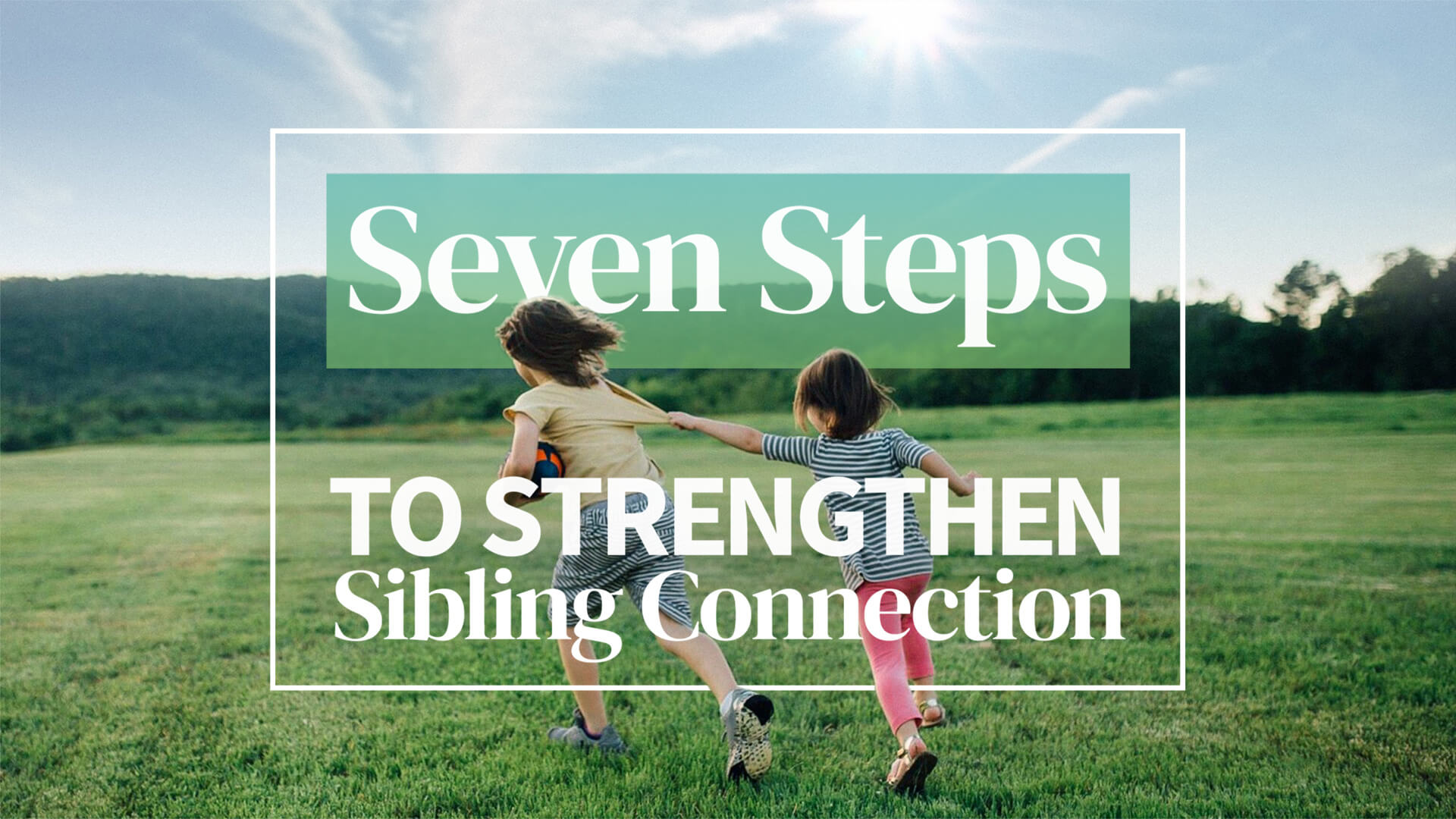
My father lectured my brothers and me about sibling rivalry when we were kids. It was a formal talk at the dining room table. I don’t remember much of that conversation but as I reflect on my childhood, that single discourse stands out to me as the only support that I remember receiving regarding my sibling relationships. And to be honest, it wasn’t very supportive.
There are as many points of view on sibling relationships as there are parents. Each parent has a lifetime of experiences that inform their parenting styles, beliefs, and reactions. Some of the ways that we respond to our kids are conscious, intentional, and aligned with our parenting values. Others are unconscious and automatic. When you feel triggered by something your child says or does, your response is likely informed by your own childhood experiences and how you were parented.
I’d like to share what helps in my family and what I recommend to my clients. For parents with an only child, these ideas work just as well in helping children navigate friendship dynamics as they do sibling relationships.
1. Prioritize Safety
Physical and emotional safety should always be the top priority. If one child is about to hurt another, it’s important to intervene quickly and calmly. Move your body in between two children who may be about to lunge toward each other and state calmly, “I won’t let you hurt each other. I’m here to keep you safe. Let’s all take a moment to breathe.”
Similarly, if one child is using words to taunt or tease his sibling, coming close and calmly stating your family’s values can decrease the tension. “In our family, we value kindness. If you’re upset, let your sister know, but I won’t allow you to call her names.”
2. Avoid Comparing
Parents sometimes unwittingly set their kids up for sibling rivalry by comparing them to each other. Sometimes one child is compared favorably: “You’re such a good reader. I wish your brother would pick up a book once in a while.” Other times, she may be compared unfavorably: “I wish you were as neat as your sister. Her room is always so organized.”
It’s more effective to relate to each individual child based upon their own unique qualities and strengths. “You really seem to enjoy reading. I’d love to hear more about your new book series.” Or if you have a concern, keep it about the child you’re addressing, without adding an unfavorable comparison to her sibling. “I’m concerned about your bedroom. Would you please set aside some time this weekend to pick up your floor?”
3. Avoid Assigning Labels
Over time, certain dynamics can lead to role assignments. One child may be labeled a bully or instigator, while the other may be labeled the victim. Sometimes these roles are related to birth order, with an older child picking on a younger sibling, but not always. Sometimes it’s the younger sibling who teases an older one.
The important thing here is for parents to be conscious of their own narratives about their kids and to look for and highlight examples of prosocial behaviors in each. For example, if you have a child who has historically teased her brother, make sure to acknowledge the times when she is kind or generous with him. Allow those altruistic acts to be included in her developing sense of self.
And if you have a child who is sometimes viewed as the victim in his sibling relationship, you can empower him to express his feelings and boundaries and support him by making sure that those boundaries are respected. Not only does this response allow kids to have a more well rounded and nuanced experience of themselves, it also minimizes the risk of them being stuck in that assigned identity throughout their lives.
4. Acknowledge and Validate Feelings
If one child is expressing feelings about his sibling, acknowledging the feelings goes a long way in diffusing them. Some parents worry that validating challenging feelings such as anger will increase the likelihood of a child having angry feelings. The opposite is actually true.
When a child feels heard and understood by his parent, he’s able to move through the challenging feeling more gracefully, rather than having the temporary emotion turn into longer lasting resentment. I believe that validation is one of the most important tools we have to foster secure relationships with our children and within our families.
5. Process Anger and Resentment
Some siblings have years-long resentments toward each other and may need support with processing their anger. As mentioned above, acknowledging and validating feelings will mitigate some of the anger.
It can also be helpful to encourage your child to find safe ways to express his feelings by drawing, writing, or through play. And when parents move into a more supportive and empathetic role, rather than refereeing or taking a hands-off approach, these sibling relationships have an opportunity to heal.
6. Encourage Problem Solving
When siblings are struggling with each other, see the struggle as an opportunity to teach problem solving. Narrate what you’re observing and then ask for their ideas about solutions. “You’re both wanting to read the same book right now and we only have one copy. How can we solve this? What would feel fair to you both?” When children are given the opportunity to facilitate a solution, it not only helps diffuse the conflict, but teaches them an important life skill.
If they’re having trouble coming to an agreement, let them know that you trust in their ability to figure something out. If they’re really stuck, you can offer some ideas. “Should we flip a coin to see who goes first? Would you like to read the first chapter together?”
7. Establish Special Time
Sibling rivalry and conflicts are rooted in a feeling of needing to compete for scarce resources. When a new child enters a family, it’s natural for the older sibling(s) to experience some anxiety about their place in the family in relation to the new baby. Will I still be important? Will there be enough love for all of us? How can I get my needs met when so much time and resources are being given to the little one?
In addition to giving our kids space to express their worries and fears, setting aside some special time for each individual child goes a long way in allaying their fears of no longer being special in light of the attention given to their sibling. Aim for 15 minutes of uninterrupted, screen free time with each child. If your schedule allows for more time, even better.
The activity can be as simple as reading a book, playing cards, or enjoying a snack. As much as possible, let your child choose and guide the activity.

How This Looks in Action
Imagine hearing your kids arguing in another room. Notice what’s happening in your body as you hear their voices amplify. If you notice muscle contraction in the body, see if you can soften and relax the areas of tension. Take a full inhale and visualize the breath going into the areas of your body that feel the most tense. Bring some awareness to the story that’s coming up for you as you hear your children arguing:
Are you assigning roles, making one child the bully and the other the victim?
Is there a fearful story about this sibling dynamic never getting easier, or a memory of your own complicated relationship with a sibling?
As you bring mindfulness to these stories, see if you can temporarily set them aside and enter the situation with a beginner’s mind.
Offer empathy to yourself, acknowledging the stress that you might be feeling in this moment of discord in your family. And then send some empathy to your children, while being mindful of their physical and emotional safety.
Sit down with your children and make eye contact with each of them. Offer some words of empathy, “It sounds like you’re having a really hard time right now.” Narrate what you’re observing and then ask them what they’re each needing. Elicit their ideas for solving the problem.
My youngest child surprised me when I offered this type of empathy to her after she hit her brother. I gently observed that she must have been feeling really stressed to have hurt her brother like that. “Do you need a hug?” I gently inquired. She melted into my arms and then almost immediately, with tears in her eyes, apologized to her brother and offered him the book they were arguing over.
I suspect that if I had entered that situation with harsh words and judgment towards her, she would have felt ashamed, resentful, and perhaps found a way to retaliate against her brother the next time I left the room. It can be very healing to a sibling relationship if both kids are met with empathy for their feelings and curiosity about what they’re each needing.

Time to Reflect
If you grew up with siblings, what do you remember about your childhood relationships with them? What was your position in the family? Were you the oldest, middle, or youngest? I’m a twin, which came with its own unique set of relationship dynamics.
Try to recall your own parents’ support (or lack of support) regarding your relationships with your siblings. Was there anything that they did that made your relationships with your siblings better? Was there anything that they did that made them worse? How do you get along with your siblings today? Maybe there’s something about your own sibling dynamics that influence the way that you view your children’s sibling relationships.
Sibling relationships can be complicated and at times even painful. They also have the potential to be rewarding and enriching.
As parents, we have the ability to strengthen and support our children’s sibling relationships, which in turn could lead to them having lifelong friendships with each other. If you have a close relationship with an adult sibling, then you know what a gift this can be.
